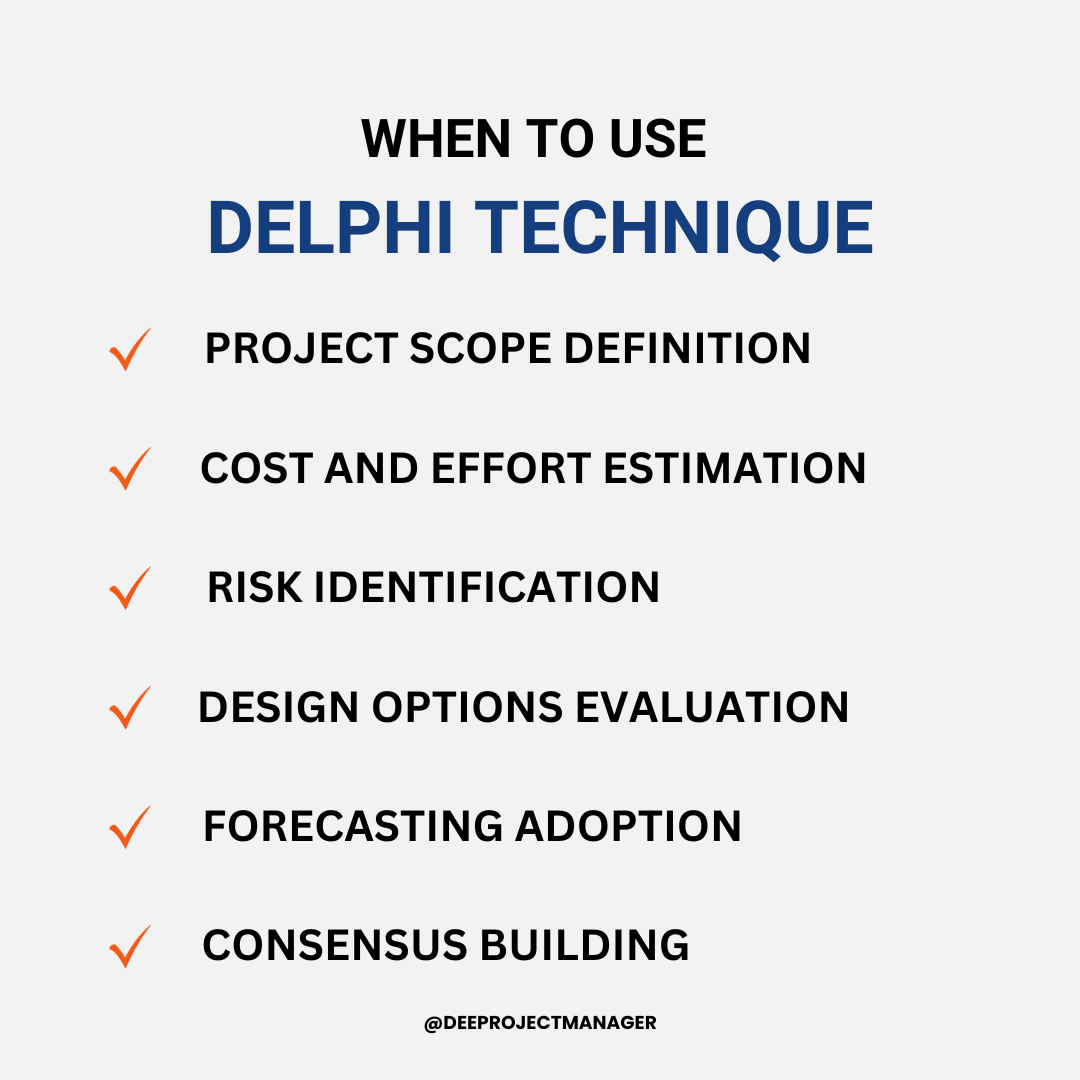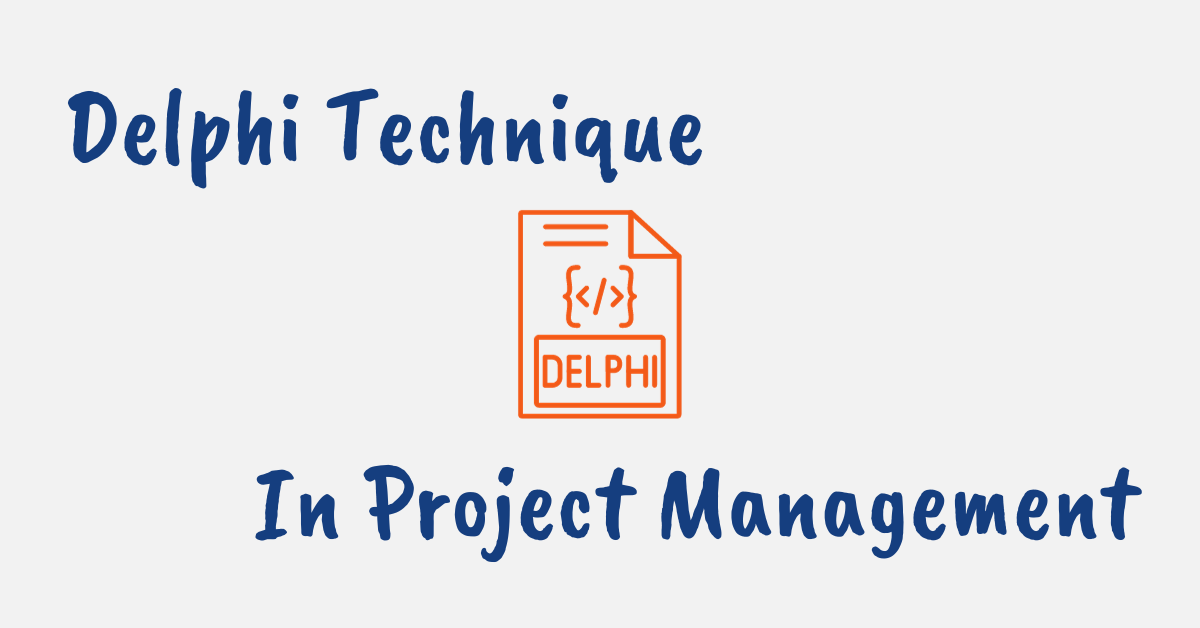As a project manager, you are going to have to make a lot of decisions that gain alignment and shared understanding with stakeholders while dealing with conflicting opinions and requirements.
This can be really challenging especially when managing large projects with multiple stakeholders with varying levels of influence and interest. And that’s where the Delphi technique comes in handy.
The Delphi method is a game-changing project management method to drive consensus and make complex decisions using an anonymous, and iterative approach by experts to provide input without influence from others.
In this post, we’ll cover the Delphi technique in project management, as well as when and how to put this method into practice to facilitate rapid decision-making for your projects.
What is the Delphi Method?
The Delphi method (also called Wideband Delphi) was developed in the 1950s by the RAND Corporation as a forecasting methodology and named after the Greek Oracle of Delphi who foretold the future.
It is a structured, iterative process to solicit expert opinions and reach a consensus on complex problems or decisions which involves a facilitator sending multiple rounds of anonymous questionnaires to a panel of subject matter experts.
After each round, the facilitator provides an anonymous summary of the experts’ responses.
Experts are then encouraged to revise their responses based on the opinions of the other members until a consensus is reached.
Typically, at least three rounds of questionnaires and controlled feedback are conducted before concluding the process. However, additional rounds can be performed until consensus is achieved.

Delphi Technique Definition in Project Management
The Delphi technique can be defined as a project management method that leverages the collective intelligence of a group of experts to achieve agreement on difficult concepts, plans, or forecasts.
It is characterized by:
- Anonymity of responses
- Multiple iterations of questionnaires and controlled feedback
- Statistical analysis of group responses
- Seeking consensus amongst a panel of experts through facilitated debate
Key goals of the technique include accurately forecasting future events, evaluating possible solutions, and aligning stakeholder perspectives on complex decisions through standardized solicitation of expert opinions.

Essential Components of the Delphi Technique
Four key components make up the structure of an effective Delphi method for consensus building and forecasting. These are:
1. Panel of Experts
A Delphi panel consists of experts who have a deep understanding of the issue being studied.
These experts can be drawn from within the organization or externally. Participants are usually stakeholders in the problem’s solution.
The number of experts can range from 10 to 50 people, depending on the scope of the problem.
Larger panels are typically segmented into smaller groups managed by an individual facilitator.
2. Facilitator
The facilitator is responsible for administering the Delphi process. Their role is to develop the questionnaires, distribute them to panelists, collect and analyze responses, and give anonymous feedback between rounds.
The facilitator should have strong written and analytical skills. They should also be able to clarify and synthesize complex ideas from the experts into useful summaries.
3. Iterative Questionnaires and Controlled Feedback
The process relies on experts completing questionnaires focused on making forecasts, evaluating solutions, or gathering informed opinions on the problem being discussed.
After each round, the facilitator summarizes the responses and themes that emerged.
This summary report is shared with the panelists to use as they re-evaluate their initial responses for the next round.
4. Anonymity
Anonymity of responses is key throughout the process. Participants are usually not brought together in face-to-face meetings to avoid undue influence.
This allows experts to freely share their opinions without pressure to conform to group thinking. Anonymity encourages open, thoughtful input.

When to Use the Delphi Method in Project Management
The Delphi technique is an excellent consensus-building tool for complex project decisions that lack historical precedent or data.
It is extremely useful during project planning when critical decisions must be made but there is uncertainty or disagreement
Here are common project situations where applying the Delphi method can be beneficial:
- Defining Project Scope: The Delphi technique can help clarify objectives, deliverables, and requirements when the project scope is ambiguous.
- Estimating Effort and Costs: Experts can provide data points to estimate project budget, effort, or other metrics when there are no analogous projects.
- Identifying Risks: Panelists can highlight potential risks, especially for new or innovative projects. Their input helps develop risk mitigation plans.
- Evaluating Design Options: Experts can evaluate the strengths and weaknesses of different design options to find optimal solutions.
- Forecasting Adoption: Panelists can estimate adoption rates for new products or technology where forecasts from historical data are impossible.
- Building Consensus: The technique brings alignment when stakeholders have major disagreements on project execution.
How to Use the Delphi Technique in Project Management
Here are steps to apply the Delphi technique to drive consensus and informed decision-making on your projects:
- Frame the Problem: Clearly define the issue you want expert input on. For example, determining project costs, evaluating potential risks, or gaining agreement on requirements. Be as specific as possible.
- Select Experts: Recruit a panel representing diverse knowledge and viewpoints on the topic. Usually, 15-30 experts are needed. Identify respected thought leaders to lend credibility.
- Appoint a Facilitator: Choose an unbiased facilitator proficient in summarizing qualitative data and guiding the discussion. A project team member can serve as a facilitator.
- Distribute Round 1 Questionnaires: Develop open-ended questionnaires to gather unfiltered input from experts. Leave room for comments and explanations.
- Analyze Round 1 Responses: The facilitator reviews, analyzes, and groups similar responses into overarching themes. Differing perspectives are noted.
- Share Anonymous Summary: Create a report highlighting areas of agreement and disagreement. Provide to panelists along with the questionnaire for round 2.
- Gather Round 2 Inputs: Experts submit updated responses after considering findings from round 1. Comments can be appended to original answers.
- Repeat Expert Feedback Rounds: Perform additional iterative rounds of sharing anonymous summaries and gathering expert feedback until consensus starts emerging.
- Assess Consensus Achievement: The facilitator determines when a consensus threshold is reached based on percentages of panelist agreement.
- Finalize Recommendation Report: Create a final report for leadership synthesizing expert consensus achieved. Include any remaining dissenting views.
- Communicate Decision: Share final decisions based on expert consensus with stakeholders. Implement the recommendations.

Delphi Technique Example
For some more clarity. let’s walk through an example of applying the Delphi technique for risk management on a new software development project.
The project manager first clearly defines the problem to solve: “Identify and prioritize potential risks for our custom mobile app development project.”
She then assembles a panel of 15 experts including lead developers, QA professionals, project managers from prior mobile projects, and UX designers.
The manager appoints herself as a facilitator since she understands the project scope well enough to analyze and summarize the qualitative risk data.
In round 1, she asks panelists to anonymously submit the top 5 risks they foresee based on past experience.
The experts highlight risks like inadequate testing, unexpected feature creep, integration issues with APIs, bugs in third-party code, and delays in getting customer feedback.
The facilitator consolidates the list and calculates the frequency of each risk cited. She produces a summary report with testing, feature creep, and API integration emerging as the top risks.
For round 2, the facilitator asks experts to re-evaluate their top 5 risks based on the aggregated data and provide rationale behind their rankings.
Feature creep moves down most lists while testing remains top-ranked based on mobile app complexity.
In the final round, the panelists anonymously assign criticality scores to the risks. The facilitator calculates average scores for each risk to produce a prioritized risk register for the project.
This Delphi approach provided a structured consensus-building technique to identify and prioritize key project risks by using experts to provide informed perspectives rather than relying on assumptions or conventional wisdom.

Delphi Technique Advantages and Disadvantages
The Delphi technique offers some key benefits as well as drawbacks when applied to project management scenarios.
Benefits of Using the Delphi Method in Project Management
- Mitigates Groupthink: Anonymity reduces biases from dominant personalities that can skew outcomes in group discussions. Shy experts can express opinions freely.
- Structured Asynchronous Participation: Experts can complete questionnaires conveniently versus scheduling group workshops. Remote teams can easily participate.
- Informed Decision-making: Consensus drawn from experts with deep topical knowledge is more data-driven than relying on assumptions.
- Builds Stakeholder Alignment: Developing shared agreement and understanding between experts increases buy-in and adoption when executing decisions.
- Allows Reasoned Persuasion: Sharing knowledge over iterative rounds influences experts to thoughtfully review positions and move toward consensus.
Drawbacks of Using the Delphi Method
- Time-consuming: With multiple lengthy rounds of questions and controlled feedback, achieving consensus can take significant time.
- Attrition Risks: Participants may drop out over successive rounds, limiting the diversity of inputs. There is often the need to over-recruit experts initially.
- Conformity Risks: Panelists may feel pressure to conform to ideas from influential experts rather than voicing dissenting opinions.
- Ambiguous Level of Agreement: Consensus thresholds vary and are ultimately determined subjectively by the facilitator.
- Risk of Manipulation: An unethical facilitator could influence opinions by selectively highlighting or suppressing viewpoints when summarizing feedback.

Delphi Technique PMP Certification Exam Tips
According to the Project Management Book of Knowledge (PMBOK) Guide 6th Edition, project management encompasses 10 knowledge areas and 49 accompanying processes.
Each of these processes has its inputs, tools, techniques, and outputs (ITTOs). The Delphi technique can be utilized primarily during the following processes:
- Collect Requirements: Experts determine requirements for the project scope.
- Develop Project Charter: Consulting experts to define goals, deliverables, costs, and risks
- Estimate Activity Durations: Experts estimate task durations in the absence of historical data
- Develop Schedule: Expert input on sequence, dependencies, and schedule development
- Identify Risks: Specialists identify threats and opportunities across the project
- Perform Qualitative Risk Analysis: Experts prioritize risks for further quantitative analysis
For the PMP exam, be familiar with the methodology, components, and applications of the Delphi technique.
Also, recognize scenarios where applying Delphi analysis could drive more informed forecasts and decisions on projects.
Conclusion
Applying Delphi analysis enhances project management by moving critical decisions from guesswork to data-driven validation.
The technique can bring alignment and minimize risks, transforming how you make decisions on future projects.
Leveraging controlled anonymity and structured sharing of expert perspectives allows informed decisions to emerge.
While conducting multiple iterations requires effort, the benefits often outweigh the costs for high-stakes project variables.
FAQs
Is the Delphi Technique Qualitative or Quantitative?
The Delphi Technique is primarily a qualitative research method. It uses experts’ opinions gathered through multiple rounds of questionnaires to achieve consensus on a specific topic.
However, it can incorporate quantitative elements like statistical analysis of the responses.
What are the 4 Techniques of Delphi?
The four primary techniques of the Delphi method are:
Anonymity: Participants’ identities remain hidden.
Iteration: Multiple rounds of questionnaires are conducted.
Controlled Feedback: Participants receive a summary of responses after each round.
Statistical Aggregation of Group Response: Final consensus is reached through analysis.
Who Developed the Delphi Technique?
The Delphi technique was developed in the 1950s by the RAND Corporation. They pioneered the method as a systematic and interactive forecasting approach and applied it as part of a US-sponsored military project.
Since then, Delphi has been adapted and used widely for consensus building in business and project management contexts.
Is Delphi Technique a Secondary Source?
No, the Delphi technique is not considered a secondary source. It is an organized methodology for gathering expert opinions to build consensus. The outputs of a Delphi technique process like reports could be secondary sources.
However, the technique itself is an interactive, qualitative research method rather than a discrete information source.
Is Delphi Technique Effective?
The Delphi Technique can be highly effective in achieving consensus among experts, particularly for complex problems where data may be scarce or non-existent.
However, its effectiveness can depend on factors like the expertise of participants, the quality of questions, and the feedback provided.
What is the Delphi Technique Particularly Well Suited To?
The Delphi Technique is particularly well-suited to exploring complex problems, developing forecasts, and decision-making in areas where precise data is scarce.
It’s effective in gaining consensus among experts, which makes it ideal for policy development, planning, and priority setting.
What is the Delphi Method Structure?
The Delphi method structure involves:
Problem Identification: Define the issue or question.
Selection of Experts: Identify individuals with knowledge on the topic.
Round of Questions: Conduct the first anonymous questionnaire round.
Feedback: Share summarized responses.
Subsequent Rounds and Consensus: Repeat steps 3 and 4 until consensus is reached.





